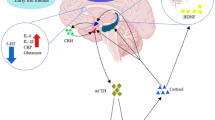Abstract
Very few neurological research is published regarding health effects of global economic crisis. Our aim was to assess the impact of economic recession on frequency and severity of headaches. We also tested if depression, anxiety and experiences associated with crisis, such as unemployment, were reflected in headaches. This is a retrospective observational study in the Emergency setting of tertiary Clinic from 1 January 2008 until 31 December 2009 and from 1 January 2010 until 31 December 2011. Demographic data were collected of 1094 consecutive adult patients with headache. Multinomial logistic regression performed to examine if hospital anxiety depression (HAD), HAD anxiety, experience of serious life events, year of survey had influence on type of headache. The total number of headache cases increased significantly from 2008 to 2011 (p < 0.001). Tension type and medication overuse headaches remained unchanged over time (p > 0.05), while migraines decreased. Secondary and not otherwise specified (NOS) increased significantly (p < 0.05). The most common, overtime, was Tension type headache, followed by migraines (in 2008, 2011) and NOS (2010). Chi square test showed significant correlation between type of headache and year, as well medication type and year (p < 0.05). Common analgesics, the most common medication, increased five times during survey period (77 % 2008 to 87.6 % 2011). Multivariate analysis revealed stronger association for experience serious events with NOS vs. tension type headache [odds ratio (OR) 0.13; 95 % confidence interval (CI) 0.03, 0.7]. This is the first study showing that the prolonged economic crisis affected headache frequency accompanied by a higher use of analgesics.
Similar content being viewed by others
References
Stovner LJ, Hagen K, Jensen R, Katsarava Z, Lipton R et al (2007) The global burden of headache: a documentation of headache prevalence and disability worldwide. Cephalalgia 27:193–210
Morgenstern L, Huber CH, Luna-Gonzales H, Saldin KR, Grotta JC et al (2001) Headache in the emergency department. Headache 41:537–541
Μaizels M (2001) Headache evaluation and treatment by primary care physicians in an emergency department in the era of triptans. Arch Intern Med 161(16):1969–1973
Eurostat (2011) Cross-sectional European Union statistics on income and living conditions (EU SILC), 2007 and 2009 users’ database. European Commission, Eurostat, Luxembourg
Kentikelenis A, Karanikolos M, Papanicolas I, Basu S, McKee M et al (2011) Health effects of financial crisis: omens of a Greek tragedy. Lancet 22 378(9801):1457–1458. doi:10.1016/S0140-6736(11)61556-0
Dermitzakis ΕV, Georgiadis G, Rudolf J, Nikiforidou D, Kyriakidis P et al (2010) Headache patients in the emergency department of a Greek tertiary care hospital. J Headache Pain 11:123–128. doi:10.1007/s10194-009-0178-3
Headache Classification Subcommittee of the International Headache Society (2004) The international classification of headache disorders: 2nd edition. Cephalalgia 24:9–160
Zigmond AS, Snaith RP (1983) The hospital anxiety and depression scale. Acta Psychiatr Scand 67:361–370
Michopoulos I, Douzenis A, Kalkavoura C, Christodoulou C, Michalopoulou P et al (2008) Hospital Anxiety and Depression Scale (HADS): validation in a Greek general hospital sample. Ann Gen Psychiatry 6(7):4. doi:10.1186/1744-859X-7-4
World Medical Association (2013) World Medical Association Declaration of Helsinki: ethical principles for medical research involving human subjects. JAMA 310(20):2191–2194. doi:10.1001/jama.2013.281053
Schwartz BS, Stewart WF, Simon D (1998) Lipton RB (1998). Epidemiology of tension-type headache. JAMA 279(5):381–383
Friedman BW, Grosberg BM (2009) Diagnosis and management of the primary headache disorders in the emergency department setting. Emerg Med Clin N Am 27(1):71–87
Thoits PA (2010) Stress and health—major findings and policy implications. J Health Soc Behav 51(Suppl):S41–S53. doi:10.1177/0022146510383499
Relja G, Granato A, Capozzoli F, Maggiore C, Catalan M et al (2005) Nontraumatic headache in the emergency department: a survey in the province of Trieste. J Headache Pain 6:298–300
Fodden DI, Petafield RC, Milsom PL (1989) Beware the patient with a headache in the accident and emergency department. Arch Emerg Med 6:7–12
Goldstein JN, Camargo CA, Pelletier AJ, Edlow JA (2006) Headache in United States emergency departments: demographics, work-up and frequency of pathological diagnoses. Cephalalgia 26:684–690
Ruiz FB, Santos MS, Siqueira HS, Cotta UC (2007) Clinical features, diagnosis and treatment of acute primary headaches at an emergency center: why are we still neglecting the evidence? Arq Neuropsiquiatr 65:1130–1133
Blumenthal HJ, Weisz MA, Kelly KM, Mayer RL, Blonsky J (2003) Treatment of primary headache in the emergency department. Headache 43:1026–1031
De Carli GF, Fabbri L, Cavazzuti L, Roncolato M, Agnello V et al (1998) The epidemiology of migraine: a retrospective study in Italian emergency departments. Headache 38(9):697–704
Sahai-Srivastava S, Desai P, Zheng L (2008) Analysis of headache management in a busy emergency room in the United States. Headache 48:931–938. doi:10.1111/j.1526-4610.2008.01156
Westergaard ML, Holme Hansen E, Glu¨mer C et al (2014) Definitions of medication-overuse headache in population-based studies and their implications on prevalence estimates: a systematic review. Cephalalgia 34:409–425
Juang KD, Wang SJ, Fuh JL, Lu SR, Su TP (2000) Co-morbidity of depressive and anxiety disorders in chronic daily headache and its subtypes. Headache 40:818–823
Mitsikostas DD, Thomas AM (1999) Co-morbidity of headache and depressive disorders. Cephalalgia 19:211–217
Kaynak Key FN, Donmez S, Tuzun U (2004) Epidemiological and clinical characteristics with psychosocial aspects of tension-type headache in Turkish college students. Cephalalgia 24:669–674
Zwart JA, Dyb G, Hagen K, Odegard KJ, Dahl AA et al (2003) Depression and anxiety disorders associated with headache frequency. The Nord-Trøndelag Health Study. Eur J Neurol 10(2):147–152
Madianos M, Economou M, Alexiou T, Stefanis C (2011) Depression and economic hardship across Greece in 2008 and 2009: two cross-sectional surveys nationwide. Soc Psychiatry Psychiatr Epidemiol 46:943–952. doi:10.1007/s00127-010-0265-4
Chinta R, Rao MB, Narendran N, Malla G, Joshi H (2013) Economic recession and headache-related hospital admissions. Hosp Top 91(2):37–42. doi:10.1080/00185868.2013.806011
Author information
Authors and Affiliations
Corresponding author
Ethics declarations
Conflict of interest
The authors have nothing to declare.
Electronic supplementary material
Below is the link to the electronic supplementary material.
Rights and permissions
About this article
Cite this article
Bougea, A., Spantideas, N., Anagnostou, E. et al. Understanding of headache patterns modification in an emergency department during the economic crisis of Greece. Neurol Sci 37, 1233–1239 (2016). https://doi.org/10.1007/s10072-016-2572-3
Received:
Accepted:
Published:
Issue Date:
DOI: https://doi.org/10.1007/s10072-016-2572-3




